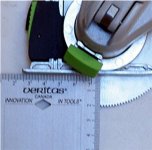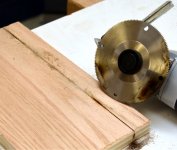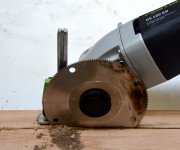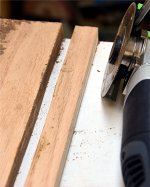Frank Pellow
Member
- Joined
- Jan 16, 2007
- Messages
- 2,743
I have read and seen several reviews of the Vecturo as well as searched in vain for a good user's manual (such as the ones the Rick Christopherson has written for other tools). I did pick up a lot of useful information and tips (particularly from Peter Parfitt) but could not find much at all about the best way to use the circular wood blade (500139).
I haven't done any real work with the blade but I have done some experimentation. I'm going to talk about my experience so far with the blade and hope that some folks with more experience can correct and/or add to what I have said.
As a test, I cut a length of 19mm thick maple faced plywood sitting on top of a sheet of Melamine covered plywood.
The first thing to note is that the maximum depth of the cut that can be made is 2 centimetres:
[attachthumb=1]
I drew a straight line on the plywood then started to cut along the line with the Vecturo set at speed 4 and cutting at full depth. I found it somewhat difficult to keep the blade on the line and there was a lot of burning. [sad]
[attachthumb=2]
So, I stopped and set the speed to 1. Then, using the Vecturo, I scored the cut at a depth of about 3mm. Having first done that, I cut at full depth following the scored line.
[attachthumb=3]
The tool was much easier to control and there was little or no burning. [smile]
The end result was a straight cut with no marking of the underlying Melamine:
[attachthumb=4]
I observe that it took longer to make this cut than I would have expected. Probably my expectations were too optimistic, but maybe someone can tell be a better and faster technique.
I haven't done any real work with the blade but I have done some experimentation. I'm going to talk about my experience so far with the blade and hope that some folks with more experience can correct and/or add to what I have said.
As a test, I cut a length of 19mm thick maple faced plywood sitting on top of a sheet of Melamine covered plywood.
The first thing to note is that the maximum depth of the cut that can be made is 2 centimetres:
[attachthumb=1]
I drew a straight line on the plywood then started to cut along the line with the Vecturo set at speed 4 and cutting at full depth. I found it somewhat difficult to keep the blade on the line and there was a lot of burning. [sad]
[attachthumb=2]
So, I stopped and set the speed to 1. Then, using the Vecturo, I scored the cut at a depth of about 3mm. Having first done that, I cut at full depth following the scored line.
[attachthumb=3]
The tool was much easier to control and there was little or no burning. [smile]
The end result was a straight cut with no marking of the underlying Melamine:
[attachthumb=4]
I observe that it took longer to make this cut than I would have expected. Probably my expectations were too optimistic, but maybe someone can tell be a better and faster technique.
Attachments
-
 Vecturo with round wood blade -maximum depth is 2 centimetres.JPG87.8 KB · Views: 341
Vecturo with round wood blade -maximum depth is 2 centimetres.JPG87.8 KB · Views: 341 -
 Vecturo with round wood blade -burned when running at full speed.JPG521 KB · Views: 269
Vecturo with round wood blade -burned when running at full speed.JPG521 KB · Views: 269 -
 Vecturo with round wood blade -Cutting at speed 1 after first scoring.JPG603.1 KB · Views: 340
Vecturo with round wood blade -Cutting at speed 1 after first scoring.JPG603.1 KB · Views: 340 -
 Vecturo with round wood blade -Cut was clean and the material underneath was unmarked_0421.JPG856.2 KB · Views: 321
Vecturo with round wood blade -Cut was clean and the material underneath was unmarked_0421.JPG856.2 KB · Views: 321
